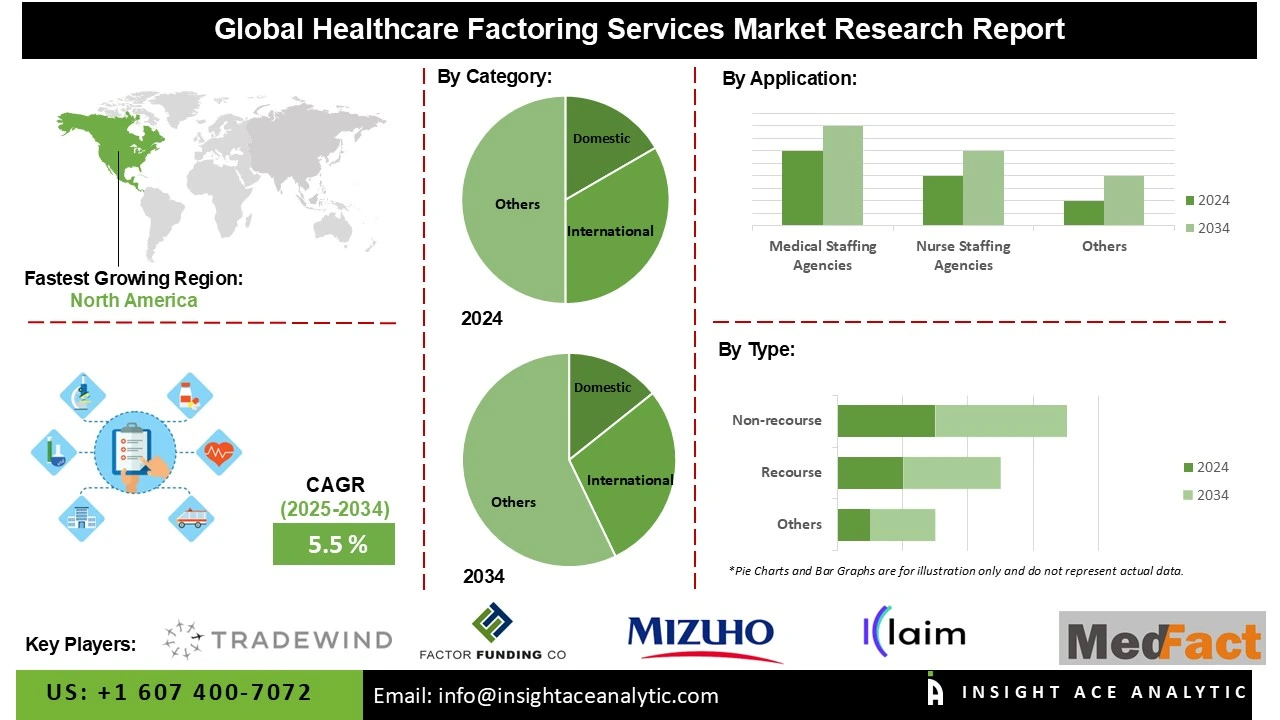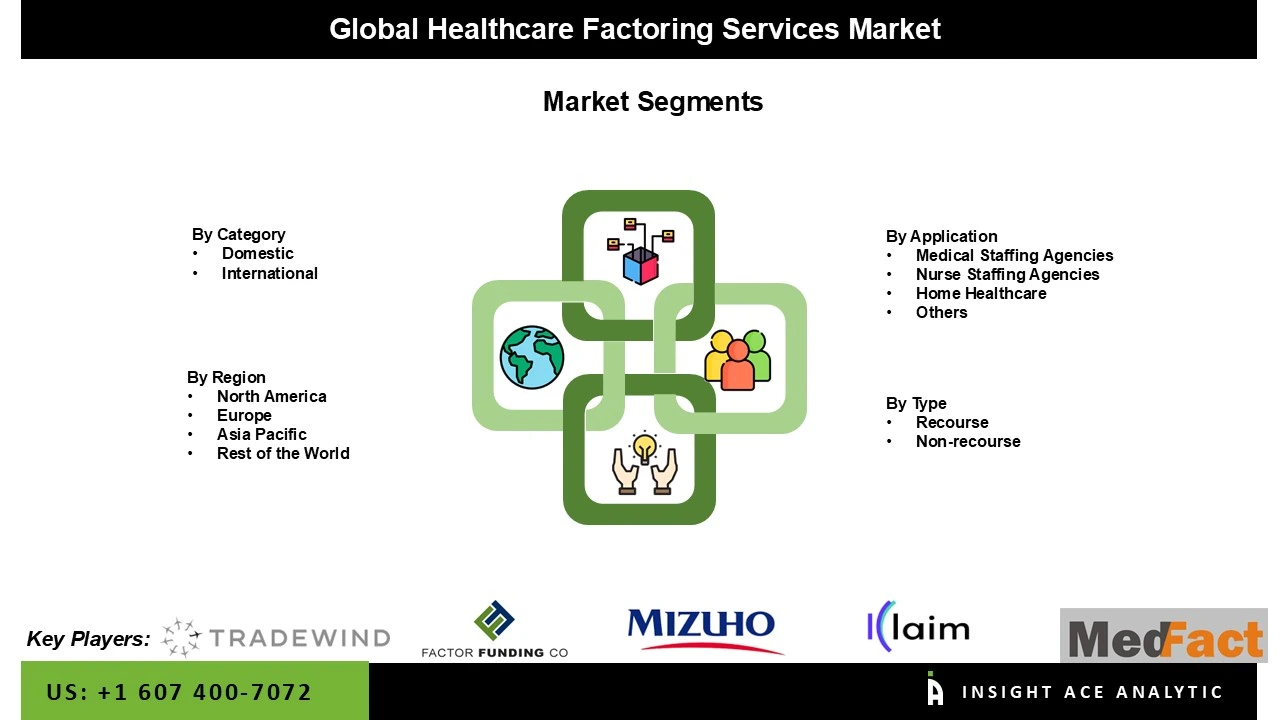Global Healthcare Factoring Services Market Size is predicted to grow at an 5.5% CAGR during the forecast period for 2025-2034.
Healthcare factoring converts slow-paying insurance and government claims into immediate working capital, smoothing cash flow and mitigating AR volatility without adding balance-sheet debt. Providers use advances to cover payroll, supplies, and invest in equipment or expansion while avoiding loan underwriting hurdles.

Funding flexibility scales with receivables and payer credit quality, helping clinics, hospitals, labs, DME suppliers, and staffing firms manage growth. Outsourced collections and back-office support reduce administrative burden, accelerate reimbursement, and preserve provider–payer relationships, while non-recourse factoring limits credit risk. The global market for Healthcare Factoring Services is expanding due to the Rising healthcare spending, increased desire for liquidity among providers, and the expanding complexity of healthcare payment systems.
The growing elderly population is a key factor driving the healthcare factoring services market. Rising cases of chronic illnesses such as diabetes, cardiovascular diseases, and cancer are increasing patient volumes and overall healthcare utilization, further intensifying the need for reliable cash-flow solutions. According to the WHO, there were 125 million people aged 80 and above in 2018, and the proportion of individuals over 60 is projected to nearly double from 12% in 2015 to 22% by 2050. Despite this demand, limited awareness of factoring options among smaller providers continues to restrain adoption. However, the integration of digital platforms and fintech-driven tools is expected to unlock significant growth opportunities for the healthcare factoring services market throughout the forecast period.
Some of the Key Players in Healthcare Factoring Services Market:
· Waqati
· MedFact
· Factor Funding Co.
· Mizuho Factors, Ltd. (a subsidiary of Mizuho Financial Group, Inc.)
· Tradewind
· Klaim AI
· PRN Funding Inc.
· Viva Capital
· Charter Capital Holdings
· US MED Capital
· Xynergy Healthcare Capital
· Porter Capital
· Factor Funding Co.
· Others
The healthcare factoring services market is segmented by category, type, and application. By category, the market is segmented into domestic and international. By type, the market is segmented into recourse and non-recourse. By application, the market is segmented into medical staffing agencies, nurse staffing agencies, home healthcare, and others.
The Domestic segment led the healthcare factoring services market in 2024. This convergence is fueled by increasing frequency of chronic diseases, growing populations, and rising healthcare spending are the main factors driving the segment's rise. Despite having limited access to traditional bank financing, they can conduct operations, maintain supply chains, and make infrastructure investments by selling receivables to factoring companies, which gives them instant access to working cash. Healthcare providers, especially smaller clinics and pharmacies, are using factoring services to deal with cash flow issues.
Recourse factoring represents the largest and fastest-growing segment, driven by the rising need for flexible financing as healthcare demand accelerates due to urbanization, population growth, and the increasing prevalence of chronic diseases. Many providers are turning to external funding to scale operations, purchase supplies, meet payroll, and upgrade infrastructure without assuming long-term debt. Recourse factoring is particularly valuable because it offers quick access to short-term liquidity, enabling organizations to pursue expansion initiatives and respond rapidly to changing patient care requirements. By avoiding prolonged waiting periods for claim settlements, healthcare providers can maintain smooth operations and support strategic growth.
North America dominated the healthcare factoring services market in 2024. The United States is at the forefront of this expansion. Because its vast, insurance‑driven healthcare system creates large receivables and long payment cycles from Medicare, Medicaid, and private payers, making factoring a common working‑capital tool for providers and vendors. A mature financial ecosystem, widespread fintech‑enabled factoring platforms, and clear legal frameworks support high adoption, while provider consolidation and complex billing/RCM workflows further expand AR volumes and demand for specialized, HIPAA‑aware factors.
With private healthcare sector becoming more and more common in the Asia-Pacific area, the healthcare factoring services market is expanding at the strongest and fastest rate in this region. Additionally, as insurance penetration climbs, and medical costs rise, swelling receivables and lengthening reimbursement cycles that favor factoring adoption. Rapid digitalization e-invoicing, real-time payments, and fintech platforms lowers onboarding friction and broadens access to working-capital solutions for clinics, hospitals, labs, and staffing firms. Coupled with SME growth and cross-border trade, these factors give APAC the highest CAGR in factoring, with healthcare a standout end-market
Chapter 1. Methodology and Scope
1.1. Research Methodology
1.2. Research Scope & Assumptions
Chapter 2. Executive Summary
Chapter 3. Global Healthcare Factoring Services Market Snapshot
Chapter 4. Global Healthcare Factoring Services Market Variables, Trends & Scope
4.1. Market Segmentation & Scope
4.2. Drivers
4.3. Challenges
4.4. Trends
4.5. Investment and Funding Analysis
4.6. Porter's Five Forces Analysis
4.7. Incremental Opportunity Analysis (US$ MN), 2025-2034
4.8. Competitive Landscape & Market Share Analysis, By Key Player (2024)
4.9. Use/impact of AI on Healthcare Factoring Services Market Industry Trends
4.10. Global Healthcare Factoring Services Market Penetration & Growth Prospect Mapping (US$ Mn), 2024-2034
Chapter 5. Healthcare Factoring Services Market Segmentation 1: By Category, Estimates & Trend Analysis
5.1. Market Share by Category, 2024 & 2034
5.2. Market Size Revenue (US$ Million) & Forecasts and Trend Analyses, 2021 to 2034 for the following Category:
5.2.1. Domestic
5.2.2. International
Chapter 6. Healthcare Factoring Services Market Segmentation 2: By Type, Estimates & Trend Analysis
6.1. Market Share by Type, 2024 & 2034
6.2. Market Size Revenue (US$ Million) & Forecasts and Trend Analyses, 2021 to 2034 for the following Type:
6.2.1. Recourse
6.2.2. Non-recourse
Chapter 7. Healthcare Factoring Services Market Segmentation 3: By Application, Estimates & Trend Analysis
7.1. Market Share by Application, 2024 & 2034
7.2. Market Size Revenue (US$ Million) & Forecasts and Trend Analyses, 2021 to 2034 for the following Application:
7.2.1. Medical Staffing Agencies
7.2.2. Nurse Staffing Agencies
7.2.3. Home Healthcare
7.2.4. Others
Chapter 8. Healthcare Factoring Services Market Segmentation 4: Regional Estimates & Trend Analysis
8.1. Global Healthcare Factoring Services Market, Regional Snapshot 2024 & 2034
8.2. North America
8.2.1. North America Healthcare Factoring Services Market Revenue (US$ Million) Estimates and Forecasts by Country, 2021-2034
8.2.1.1. US
8.2.1.2. Canada
8.2.2. North America Healthcare Factoring Services Market Revenue (US$ Million) Estimates and Forecasts by Category, 2021-2034
8.2.3. North America High-Altitude Oxygen Simulation Market Revenue (US$ Million) Estimates and Forecasts by Type, 2021-2034
8.2.4. North America Healthcare Factoring Services Market Revenue (US$ Million) Estimates and Forecasts by Application, 2021-2034
8.3. Europe
8.3.1. Europe Healthcare Factoring Services Market Revenue (US$ Million) Estimates and Forecasts by Country, 2021-2034
8.3.1.1. Germany
8.3.1.2. U.K.
8.3.1.3. France
8.3.1.4. Italy
8.3.1.5. Spain
8.3.1.6. Rest of Europe
8.3.2. Europe Healthcare Factoring Services Market Revenue (US$ Million) Estimates and Forecasts by Category, 2021-2034
8.3.3. Europe Healthcare Factoring Services Market Revenue (US$ Million) Estimates and Forecasts by Type, 2021-2034
8.3.4. Europe Healthcare Factoring Services Market Revenue (US$ Million) Estimates and Forecasts by Application, 2021-2034
8.4. Asia Pacific
8.4.1. Asia Pacific Healthcare Factoring Services Market Revenue (US$ Million) Estimates and Forecasts by Country, 2021-2034
8.4.1.1. India
8.4.1.2. China
8.4.1.3. Japan
8.4.1.4. Australia
8.4.1.5. South Korea
8.4.1.6. Hong Kong
8.4.1.7. Southeast Asia
8.4.1.8. Rest of Asia Pacific
8.4.2. Asia Pacific Healthcare Factoring Services Market Revenue (US$ Million) Estimates and Forecasts by Category, 2021-2034
8.4.3. Asia Pacific Healthcare Factoring Services Market Revenue (US$ Million) Estimates and Forecasts by Type, 2021-2034
8.4.4. Asia Pacific Healthcare Factoring Services Market Revenue (US$ Million) Estimates and Forecasts by Application, 2021-2034
8.5. Latin America
8.5.1. Latin America Healthcare Factoring Services Market Revenue (US$ Million) Estimates and Forecasts by Country, 2021-2034
8.5.1.1. Brazil
8.5.1.2. Mexico
8.5.1.3. Rest of Latin America
8.5.2. Latin America Healthcare Factoring Services Market Revenue (US$ Million) Estimates and Forecasts by Category, 2021-2034
8.5.3. Latin America Healthcare Factoring Services Market Revenue (US$ Million) Estimates and Forecasts by Type, 2021-2034
8.5.4. Latin America Healthcare Factoring Services Market Revenue (US$ Million) Estimates and Forecasts by Application, 2021-2034
8.6. Middle East & Africa
8.6.1. Middle East & Africa Wind Turbine Rotor Blade Market Revenue (US$ Million) Estimates and Forecasts by country, 2021-2034
8.6.1.1. GCC Countries
8.6.1.2. Israel
8.6.1.3. South Africa
8.6.1.4. Rest of Middle East and Africa
8.6.2. Middle East & Africa Healthcare Factoring Services Market Revenue (US$ Million) Estimates and Forecasts by Category, 2021-2034
8.6.3. Middle East & Africa Healthcare Factoring Services Market Revenue (US$ Million) Estimates and Forecasts by Type, 2021-2034
8.6.4. Middle East & Africa Healthcare Factoring Services Market Revenue (US$ Million) Estimates and Forecasts by Application, 2021-2034
Chapter 9. Competitive Landscape
9.1. Major Mergers and Acquisitions/Strategic Alliances
9.2. Company Profiles
9.2.1. Waqati
9.2.1.1. Business Overview
9.2.1.2. Key Category /Service Overview
9.2.1.3. Financial Performance
9.2.1.4. Geographical Presence
9.2.1.5. Recent Developments with Business Strategy
9.2.2. MedFact
9.2.3. Factor Funding Co.
9.2.4. Mizuho Factors, Ltd. (a subsidiary of Mizuho Financial Group, Inc.)
9.2.5. Tradewind
9.2.6. Klaim AI
Healthcare Factoring Services Market by Category
· Domestic
· International

Healthcare Factoring Services Market by Type
· Recourse
· Non-recourse
Healthcare Factoring Services Market by Application
· Medical Staffing Agencies
· Nurse Staffing Agencies
· Home Healthcare
· Others
Healthcare Factoring Services Market by Region
North America-
· The US
· Canada
Europe-
· Germany
· The UK
· France
· Italy
· Spain
· Rest of Europe
Asia-Pacific-
· China
· Japan
· India
· South Korea
· Southeast Asia
· Rest of Asia Pacific
Latin America-
· Brazil
· Argentina
· Mexico
· Rest of Latin America
Middle East & Africa-
· GCC Countries
· South Africa
· Rest of the Middle East and Africa
InsightAce Analytic follows a standard and comprehensive market research methodology focused on offering the most accurate and precise market insights. The methods followed for all our market research studies include three significant steps – primary research, secondary research, and data modeling and analysis - to derive the current market size and forecast it over the forecast period. In this study, these three steps were used iteratively to generate valid data points (minimum deviation), which were cross-validated through multiple approaches mentioned below in the data modeling section.
Through secondary research methods, information on the market under study, its peer, and the parent market was collected. This information was then entered into data models. The resulted data points and insights were then validated by primary participants.
Based on additional insights from these primary participants, more directional efforts were put into doing secondary research and optimize data models. This process was repeated till all data models used in the study produced similar results (with minimum deviation). This way, this iterative process was able to generate the most accurate market numbers and qualitative insights.

Secondary research
The secondary research sources that are typically mentioned to include, but are not limited to:
The paid sources for secondary research like Factiva, OneSource, Hoovers, and Statista
Primary Research:
Primary research involves telephonic interviews, e-mail interactions, as well as face-to-face interviews for each market, category, segment, and subsegment across geographies
The contributors who typically take part in such a course include, but are not limited to:
Data Modeling and Analysis:
In the iterative process (mentioned above), data models received inputs from primary as well as secondary sources. But analysts working on these models were the key. They used their extensive knowledge and experience about industry and topic to make changes and fine-tuning these models as per the product/service under study.
The standard data models used while studying this market were the top-down and bottom-up approaches and the company shares analysis model. However, other methods were also used along with these – which were specific to the industry and product/service under study.
To know more about the research methodology used for this study, kindly contact us/click here